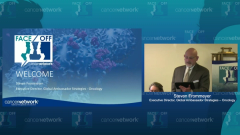
Outcome Determination for Adolescents and Young Adults with ALL
Xiaoli Mi, MD, presents data from a paper in Blood on the determination of outcomes for adolescents and young adults with ALL.
Episodes in this series

Jae Park, MD: Our last speaker from MSK [Memorial Sloan Kettering Cancer Center] is Dr Xiaoli Mi, our first-year superstar fellow. She was entering the laboratory as well with Omar Abdel-Wahab, [MD,] and is interested in lymphoid malignancy. We’re happy to have her present 2 papers for us.
Xiaoli Mi, MD: Thank you so much, Dr Park. Hi, everyone. The first paper I’ll be presenting was published by Wendy Stock, [MD,] et al in Blood in 2008. This paper was referenced by Varun Narendra, [MD,] earlier. What determines the outcomes for adolescents and young adults with acute lymphoblastic leukemia [ALL]? This is a retrospective comparison study of 321 patients with ALL between the ages of 16 and 20 who were treated in pediatric or adult cooperative group trials. Adolescents and young adults enrolled on pediatric trials have better clinical outcomes, including event-free survival [EFS] and overall survival.
CCG stands for the Children’s Cancer Group, which is the organization that led the pediatric group trials. CALGB is the Cancer and Leukemia Group B, which led the adult cooperative group trials. The 7-year EFS for patients enrolled on the CCG trials was 63% compared with 34% for patients who were enrolled on the adult CALGB trials. Similarly, we saw a big difference in overall survival. The 7-year survival for CCG patients was 67% compared with only 46% for patients who were enrolled in the adult trials.
The patients enrolled in the pediatric and adult trials were well matched in terms of sex, ethnicity, and disease subtypes. However, there was a significant difference in the age distribution. The patients enrolled on the pediatric CCG trials had a median age of 16, whereas the patients enrolled on the adult CALGB trials had a median age of 19. When the authors analyzed the age effect on EFS, separating the patients into younger adolescents between the ages of 16 and 17 and older adolescents between the ages of 18 and 20, they found that there was no significant difference in the younger patients enrolled in the pediatric vs adult trials. However, there was a significant difference in EFS for older patients who were enrolled in the pediatric vs adult trials. The 7-year EFS for patients between the ages of 18 and 20 on the CCG trials was 57% compared with 29% for patients between the ages of 18 and 20 in the adult CALGB trials.
The authors postulated that the degree of adherence to the protocols by both patients and physicians may be lower in adult practices. Furthermore, adolescents and young adults on adult trials have higher central nervous system [CNS] relapse rate. The estimated incidence rate of isolated CNS relapse at 7 years was only 1% for patients enrolled in the pediatric CCG trials, whereas the 7-year relapse rate for patients enrolled in the adult CALGB trials was 11%.
What are the key differences between the pediatric and adult regimens led by CCG and CALGB? This was mentioned by Varun earlier. The top table compares the cumulative drug doses during induction, [and] the table on the bottom compares the cumulative drug doses during postremission therapy. Patients who were enrolled in the pediatric trials received higher doses of nonmyelosuppressive drugs, including glucocorticoids such as prednisone and dexamethasone, vincristine, and L-asparaginase, whereas patients on the adult CALGB trials received higher doses of myelosuppressive drugs, such as daunorubicin and cyclophosphamide. Furthermore, patients on the pediatric trials received earlier and more intensive central nervous system prophylaxis with intrathecal methotrexate, which could explain their lower rates of CNS relapse over the long term.
In conclusion, this is a retrospective study of 321 patients with ALL aged 16 to 20 [years] who were treated in pediatric or adult cooperative group trials led by CCG vs CALGB. Despite identical complete response rates of 90%, the clinical outcomes of event-free survival and overall survival were significantly better for adolescents and young adults enrolled in the pediatric trials. Pediatric regimens have higher cumulative doses of nonmyelosuppressive agents and earlier and more intensive central nervous system prophylaxis, which might explain why pediatric regimens are associated with lower rates of CNS relapse. Interestingly, older adolescents between the ages of 18 and 20 in the adult trials have significantly worse outcomes than younger adolescents between ages 16 and 17 in both pediatric and adult trials, possibly related to lower rates of adherence.
Transcript edited for clarity.
Newsletter
Stay up to date on recent advances in the multidisciplinary approach to cancer.

















































































